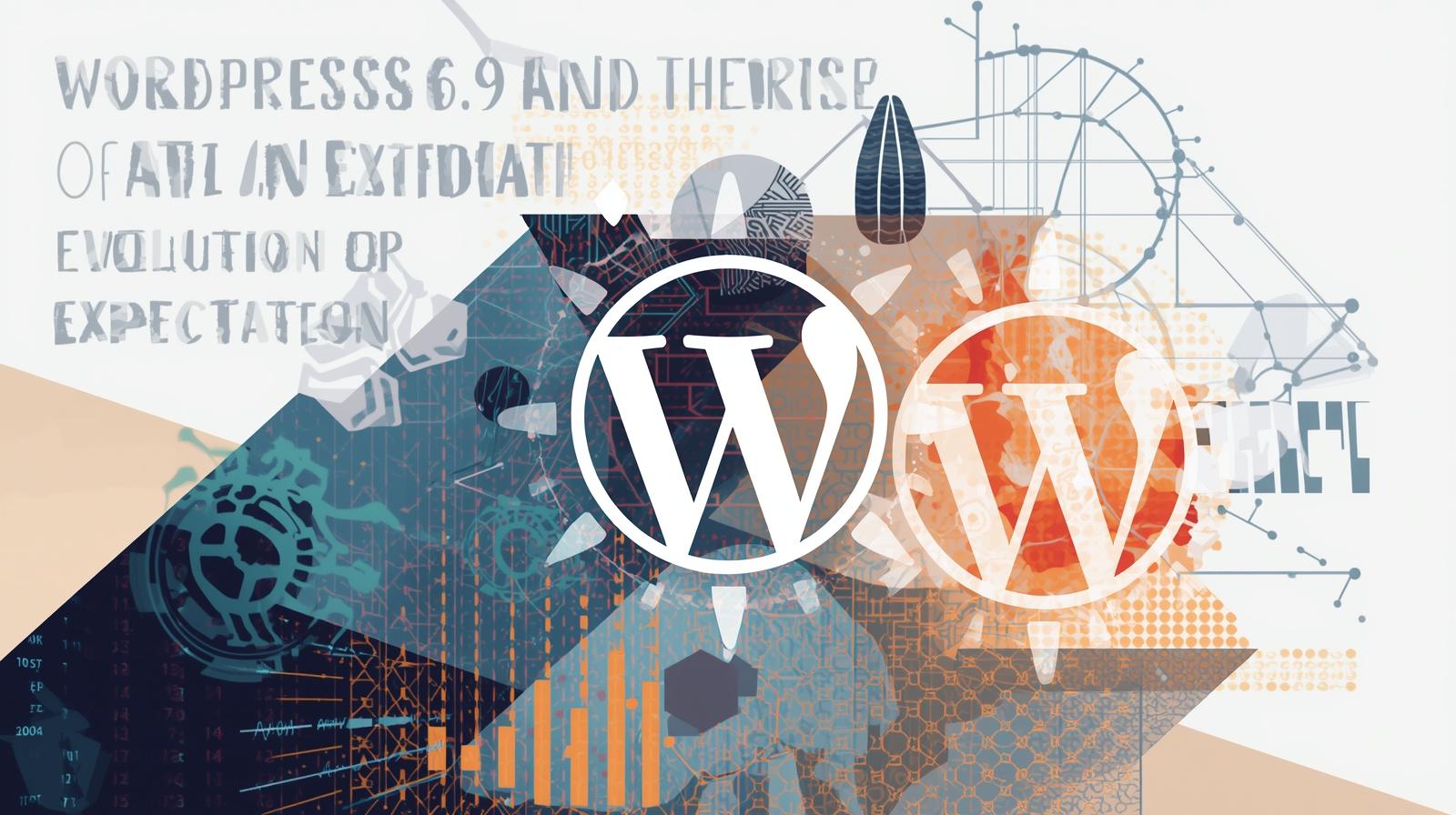As the world’s most popular content management system, WordPress continues to evolve with each release. The upcoming version, WordPress 6.9, scheduled for December 2, 2025, has generated significant anticipation – particularly around its rumored integration with artificial intelligence. Yet, while AI is indeed part of the roadmap, the real story is more nuanced. Rather than introducing flashy, user-facing AI tools, WordPress 6.9 focuses on building the technical foundations that will enable intelligent features in the future.
This article explores what’s actually coming in WordPress 6.9, how AI fits into the platform’s long-term vision, and whether these developments represent a true breakthrough or a cautious step forward.
The Context: WordPress and the AI Hype
Artificial intelligence has rapidly become a central theme in digital publishing. From AI-assisted content generation to smart design tools, creators now expect their platforms to integrate intelligent automation seamlessly. Competing CMSs like Wix and Squarespace have already introduced AI-driven assistants that generate layouts, content, and SEO suggestions.
Against this backdrop, expectations for WordPress are understandably high. However, the open-source nature of the platform means innovation often unfolds more gradually – through APIs, community plugins, and incremental updates rather than sweeping changes in the core.
WordPress 6.9 reflects this philosophy perfectly: it’s not an AI release, but an AI-ready release.
AI Foundations in WordPress 6.9: What’s Actually New
1. Abilities API – Defining What WordPress Can Do
One of the most significant technical introductions is the Abilities API. This new registry describes WordPress functions – including their inputs, outputs, and expected behavior – in a structured format.
The purpose? To make these functions machine-readable and accessible to AI systems. In other words, when a language model or an external AI agent interacts with WordPress, it can understand what each function does and how to use it safely.
As Thimpress explains, this development lays the groundwork for “AI agents to perform WordPress tasks with context and control,” such as creating posts, managing users, or adjusting settings – all within defined permissions.
2. MCP Adapter – The Bridge Between AI and WordPress
Another key component is the MCP Adapter (Model Context Protocol), introduced as a canonical plugin. This protocol standardizes communication between WordPress and large language models (LLMs), creating a secure environment for AI-based automation.
Through MCP, developers can connect WordPress to models from OpenAI, Anthropic, or other providers, enabling use cases like:
- Automated content suggestions based on existing site data.
- Intelligent summarization of comments or posts.
- AI-driven moderation or workflow assistance.
However, it’s important to note that none of these features are built into the core – they will depend on third-party plugins leveraging these APIs.
3. PHP AI Client SDK – A Common Interface for AI Providers
To simplify integration, WordPress 6.9 also introduces a PHP AI Client SDK, offering a unified way to interact with multiple AI services. This SDK abstracts the complexity of dealing with different APIs, authentication methods, and data formats.
As Trew Knowledge notes, this move empowers plugin developers to experiment with AI features without being locked into a single vendor – a critical step for maintaining WordPress’s open ecosystem.
Beyond AI: Other Key Enhancements in WordPress 6.9
While AI foundations dominate the headlines, WordPress 6.9 includes several other improvements that directly impact usability, collaboration, and performance.
Simplified Editing Mode
Designed for content authors rather than designers, the new simplified editing mode declutters the interface by hiding advanced design tools. This mode focuses on writing and structuring content – a welcome addition for teams that separate editorial and design roles.
Block-Level Commenting
Collaboration takes a leap forward with block-level commenting, allowing editors and reviewers to leave feedback directly on specific blocks. This feature introduces an asynchronous editorial workflow similar to commenting in Google Docs, enhancing teamwork within WordPress.
Template Management Overhaul
The new release also refines template management:
- Multiple templates can now share the same slug.
- Templates can be saved as drafts, activated, or deactivated.
- Templates are preserved when switching themes.
These changes make theme development and customization more flexible, especially for agencies managing multiple sites.
Command Palette Expansion
The Command Palette, introduced in earlier versions, now extends across the entire admin interface. Users can quickly execute actions, navigate panels, or search settings – and in the future, this could serve as a natural integration point for AI-driven commands.
New Blocks and Design Features
WordPress 6.9 adds several new blocks and enhancements:
- Accordion, Math, Terms Query, Time to Read, and Icon blocks.
- A “Fit Text” option for responsive typography.
- Improved block CSS loading for better performance.
These updates continue WordPress’s march toward a fully block-based, flexible editing experience.
Performance Improvements
Performance remains a top priority. According to Thimpress, 6.9 introduces:
- On-demand CSS loading for blocks.
- Moving the emoji script to the footer for faster initial rendering.
- Running cron jobs during page unloads.
- Enhanced caching and resource minification.
Together, these changes promise faster load times and smoother navigation – critical for SEO and user experience.
A Realistic Look: Evolution, Not Revolution
While the AI-related components in WordPress 6.9 are technically impressive, they are preparatory rather than transformative. Users expecting an AI assistant built into the dashboard may be disappointed. The core team’s strategy focuses on laying a secure, extensible foundation rather than rushing to deliver AI features that could compromise privacy or stability.
This cautious approach aligns with the open-source ethos: empowering the community to innovate, rather than dictating a single solution. It also reflects WordPress’s scale – powering over 40% of the web means changes must be stable, backward-compatible, and privacy-conscious.
In that sense, WordPress 6.9’s AI work is evolutionary, not revolutionary. It’s a necessary step toward a future where AI can safely assist with content creation, site management, and design – but the real innovations will likely come from plugin developers building on these APIs.
The Bigger Picture: Responsible AI in WordPress
The WordPress documentation team has also proposed a “Responsible AI Workflow” for generating and reviewing documentation using AI tools (Make WordPress Docs). This reflects a growing awareness of ethical and quality considerations around AI-generated content.
The proposal emphasizes:
- Human review of all AI outputs.
- Transparency about AI use in documentation.
- Clear guidelines for data privacy and attribution.
This measured stance reinforces WordPress’s commitment to open, responsible innovation — a key differentiator in an era of rapid, sometimes reckless AI adoption.
What It Means for Developers and Site Owners
For developers, WordPress 6.9 opens exciting possibilities:
- Building plugins that leverage AI for SEO, design, or workflow automation.
- Creating custom AI assistants tailored to specific site roles.
- Experimenting with new forms of user interaction through the Command Palette or REST API.
For site owners, however, the impact will be subtler – improved performance, better collaboration tools, and a platform quietly preparing for the AI era.
If you’re managing WordPress-based projects, now is the time to explore AI integrations through plugins and prepare your workflows for upcoming capabilities.
Conclusion: A Smart, Steady Step Toward the AI Future
WordPress 6.9 doesn’t deliver the kind of AI fireworks some might have expected, but it does something arguably more important: it builds the infrastructure for responsible, extensible, and future-proof AI integration.
By introducing the Abilities API, MCP Adapter, and AI Client SDK, WordPress is ensuring that when AI becomes a core part of the platform, it will do so on solid, open, and secure foundations.
In short, WordPress 6.9 is not the AI revolution – but it’s the groundwork for it.
Explore more about WordPress development and AI integration on developress.io – where we dive deeper into emerging trends, plugin innovation, and the evolving future of web publishing.







